Simiao Ren
Dennis
Can Multi-modal (reasoning) LLMs work as deepfake detectors?
Mar 25, 2025Abstract:Deepfake detection remains a critical challenge in the era of advanced generative models, particularly as synthetic media becomes more sophisticated. In this study, we explore the potential of state of the art multi-modal (reasoning) large language models (LLMs) for deepfake image detection such as (OpenAI O1/4o, Gemini thinking Flash 2, Deepseek Janus, Grok 3, llama 3.2, Qwen 2/2.5 VL, Mistral Pixtral, Claude 3.5/3.7 sonnet) . We benchmark 12 latest multi-modal LLMs against traditional deepfake detection methods across multiple datasets, including recently published real-world deepfake imagery. To enhance performance, we employ prompt tuning and conduct an in-depth analysis of the models' reasoning pathways to identify key contributing factors in their decision-making process. Our findings indicate that best multi-modal LLMs achieve competitive performance with promising generalization ability with zero shot, even surpass traditional deepfake detection pipelines in out-of-distribution datasets while the rest of the LLM families performs extremely disappointing with some worse than random guess. Furthermore, we found newer model version and reasoning capabilities does not contribute to performance in such niche tasks of deepfake detection while model size do help in some cases. This study highlights the potential of integrating multi-modal reasoning in future deepfake detection frameworks and provides insights into model interpretability for robustness in real-world scenarios.
Segment anything, from space?
May 15, 2023
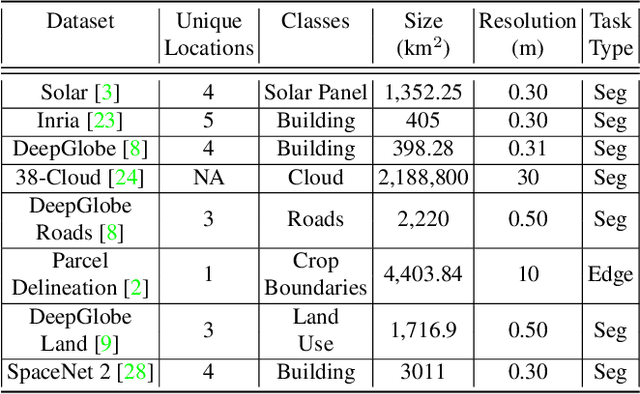
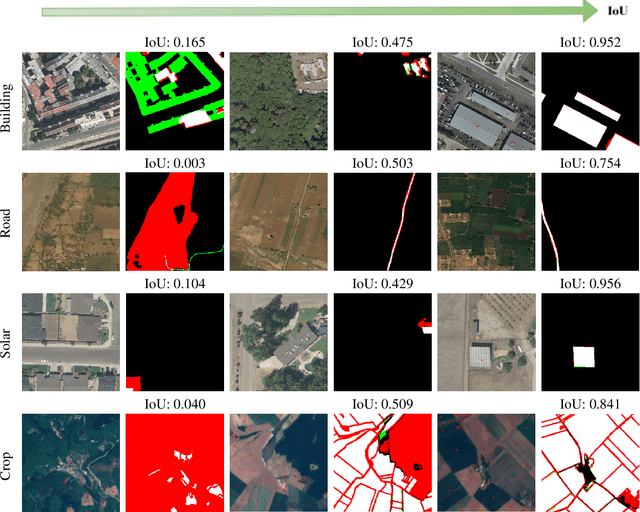
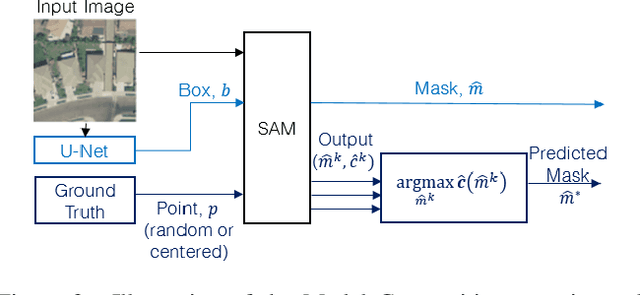
Abstract:Recently, the first foundation model developed specifically for vision tasks was developed, termed the "Segment Anything Model" (SAM). SAM can segment objects in input imagery based upon cheap input prompts, such as one (or more) points, a bounding box, or a mask. The authors examined the zero-shot image segmentation accuracy of SAM on a large number of vision benchmark tasks and found that SAM usually achieved recognition accuracy similar to, or sometimes exceeding, vision models that had been trained on the target tasks. The impressive generalization of SAM for segmentation has major implications for vision researchers working on natural imagery. In this work, we examine whether SAM's impressive performance extends to overhead imagery problems, and help guide the community's response to its development. We examine SAM's performance on a set of diverse and widely-studied benchmark tasks. We find that SAM does often generalize well to overhead imagery, although it fails in some cases due to the unique characteristics of overhead imagery and the target objects. We report on these unique systematic failure cases for remote sensing imagery that may comprise useful future research for the community. Note that this is a working paper, and it will be updated as additional analysis and results are completed.
Deep Active Learning for Scientific Computing in the Wild
Jan 31, 2023



Abstract:Deep learning (DL) is revolutionizing the scientific computing community. To reduce the data gap caused by usually expensive simulations or experimentation, active learning has been identified as a promising solution for the scientific computing community. However, the deep active learning (DAL) literature is currently dominated by image classification problems and pool-based methods, which are not directly transferrable to scientific computing problems, dominated by regression problems with no pre-defined 'pool' of unlabeled data. Here for the first time, we investigate the robustness of DAL methods for scientific computing problems using ten state-of-the-art DAL methods and eight benchmark problems. We show that, to our surprise, the majority of the DAL methods are not robust even compared to random sampling when the ideal pool size is unknown. We further analyze the effectiveness and robustness of DAL methods and suggest that diversity is necessary for a robust DAL for scientific computing problems.
Mixture Manifold Networks: A Computationally Efficient Baseline for Inverse Modeling
Nov 25, 2022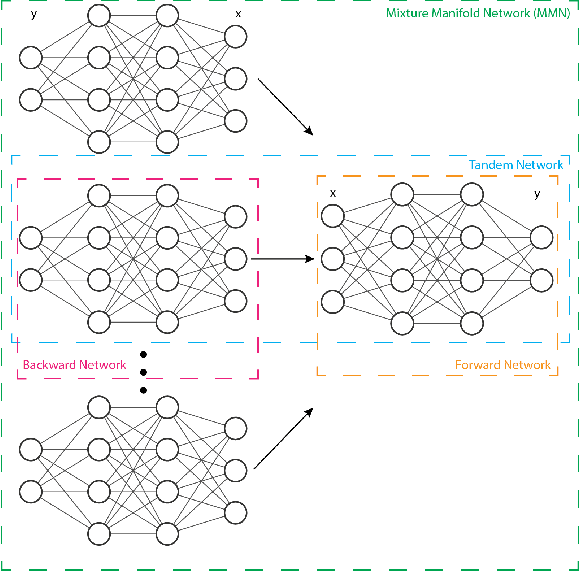
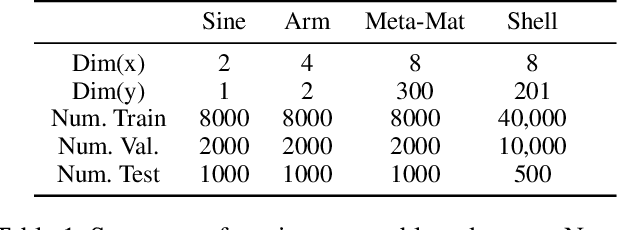
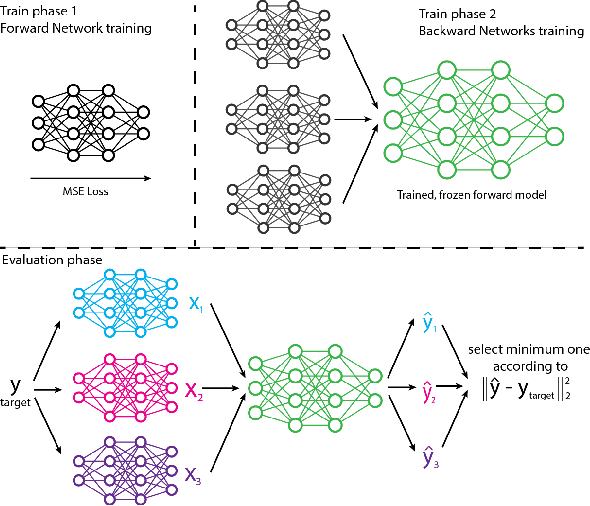
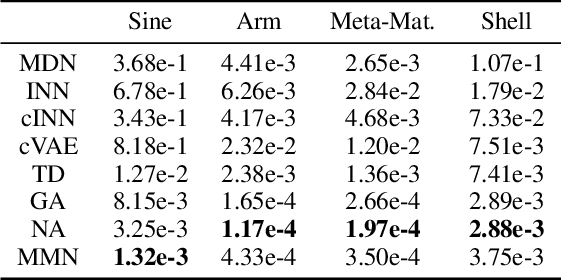
Abstract:We propose and show the efficacy of a new method to address generic inverse problems. Inverse modeling is the task whereby one seeks to determine the control parameters of a natural system that produce a given set of observed measurements. Recent work has shown impressive results using deep learning, but we note that there is a trade-off between model performance and computational time. For some applications, the computational time at inference for the best performing inverse modeling method may be overly prohibitive to its use. We present a new method that leverages multiple manifolds as a mixture of backward (e.g., inverse) models in a forward-backward model architecture. These multiple backwards models all share a common forward model, and their training is mitigated by generating training examples from the forward model. The proposed method thus has two innovations: 1) the multiple Manifold Mixture Network (MMN) architecture, and 2) the training procedure involving augmenting backward model training data using the forward model. We demonstrate the advantages of our method by comparing to several baselines on four benchmark inverse problems, and we furthermore provide analysis to motivate its design.
Automated Extraction of Energy Systems Information from Remotely Sensed Data: A Review and Analysis
Feb 18, 2022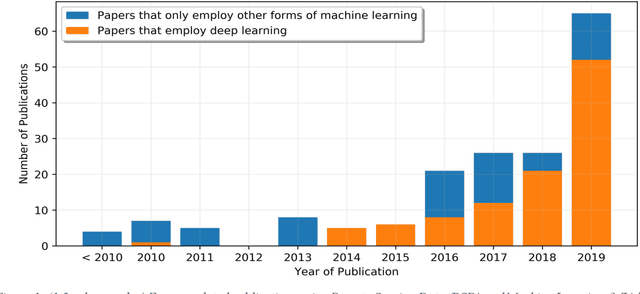
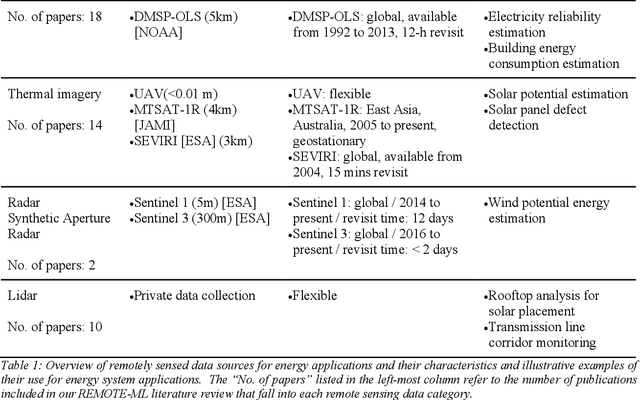
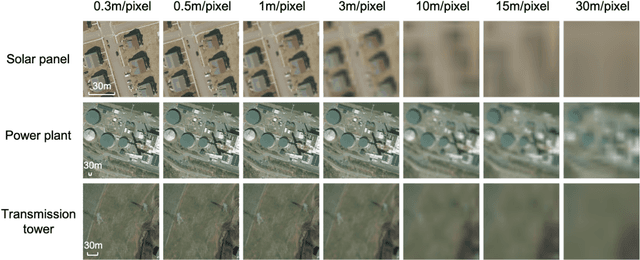
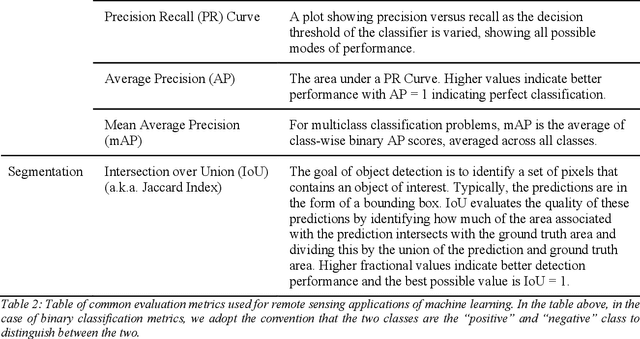
Abstract:High quality energy systems information is a crucial input to energy systems research, modeling, and decision-making. Unfortunately, precise information about energy systems is often of limited availability, incomplete, or only accessible for a substantial fee or through a non-disclosure agreement. Recently, remotely sensed data (e.g., satellite imagery, aerial photography) have emerged as a potentially rich source of energy systems information. However, the use of these data is frequently challenged by its sheer volume and complexity, precluding manual analysis. Recent breakthroughs in machine learning have enabled automated and rapid extraction of useful information from remotely sensed data, facilitating large-scale acquisition of critical energy system variables. Here we present a systematic review of the literature on this emerging topic, providing an in-depth survey and review of papers published within the past two decades. We first taxonomize the existing literature into ten major areas, spanning the energy value chain. Within each research area, we distill and critically discuss major features that are relevant to energy researchers, including, for example, key challenges regarding the accessibility and reliability of the methods. We then synthesize our findings to identify limitations and trends in the literature as a whole, and discuss opportunities for innovation.
Hyperparameter-free deep active learning for regression problems via query synthesis
Jan 29, 2022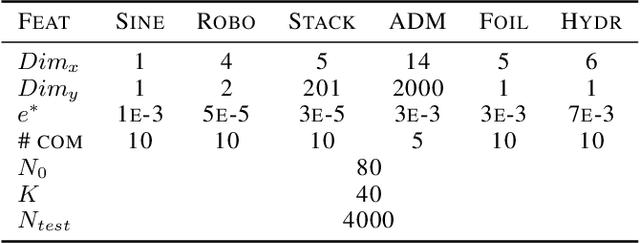
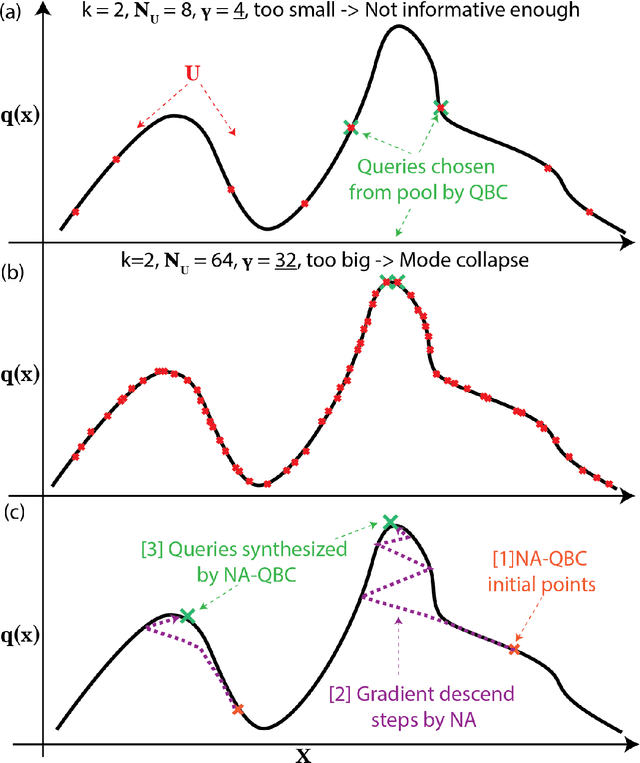
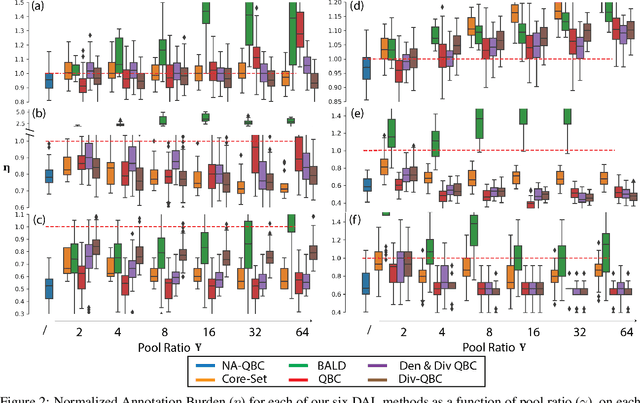
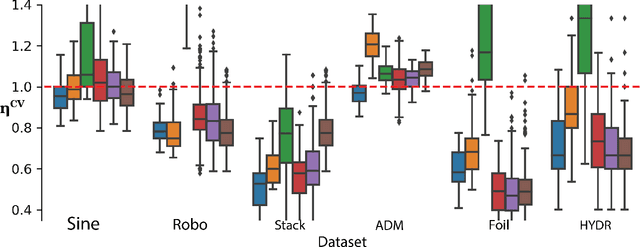
Abstract:In the past decade, deep active learning (DAL) has heavily focused upon classification problems, or problems that have some 'valid' data manifolds, such as natural languages or images. As a result, existing DAL methods are not applicable to a wide variety of important problems -- such as many scientific computing problems -- that involve regression on relatively unstructured input spaces. In this work we propose the first DAL query-synthesis approach for regression problems. We frame query synthesis as an inverse problem and use the recently-proposed neural-adjoint (NA) solver to efficiently find points in the continuous input domain that optimize the query-by-committee (QBC) criterion. Crucially, the resulting NA-QBC approach removes the one sensitive hyperparameter of the classical QBC active learning approach - the "pool size"- making NA-QBC effectively hyperparameter free. This is significant because DAL methods can be detrimental, even compared to random sampling, if the wrong hyperparameters are chosen. We evaluate Random, QBC and NA-QBC sampling strategies on four regression problems, including two contemporary scientific computing problems. We find that NA-QBC achieves better average performance than random sampling on every benchmark problem, while QBC can be detrimental if the wrong hyperparameters are chosen.
Utilizing geospatial data for assessing energy security: Mapping small solar home systems using unmanned aerial vehicles and deep learning
Jan 14, 2022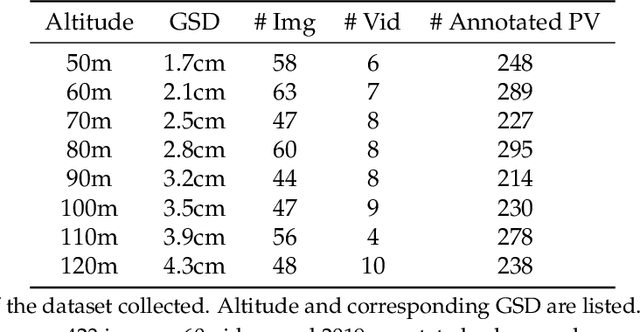
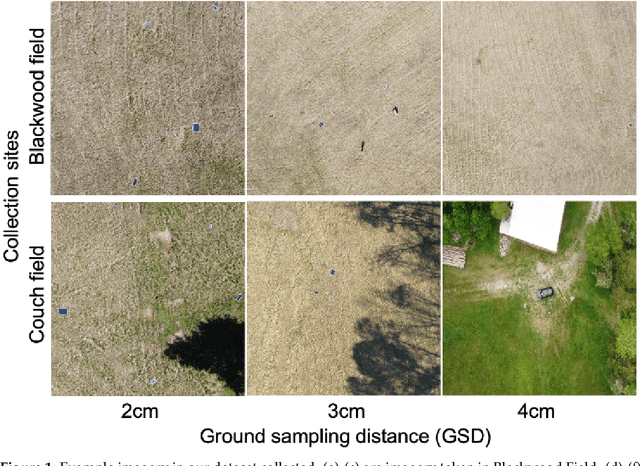

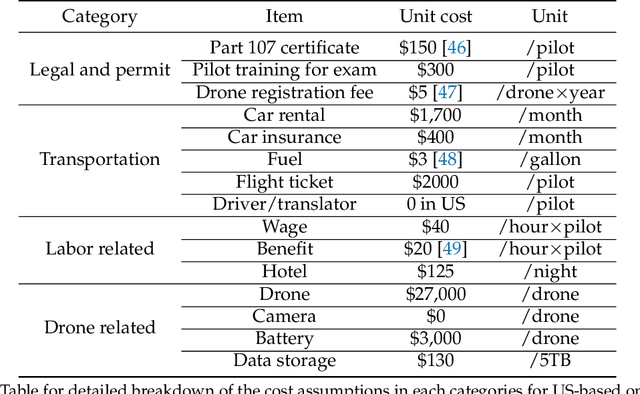
Abstract:Solar home systems (SHS), a cost-effective solution for rural communities far from the grid in developing countries, are small solar panels and associated equipment that provides power to a single household. A crucial resource for targeting further investment of public and private resources, as well as tracking the progress of universal electrification goals, is shared access to high-quality data on individual SHS installations including information such as location and power capacity. Though recent studies utilizing satellite imagery and machine learning to detect solar panels have emerged, they struggle to accurately locate many SHS due to limited image resolution (some small solar panels only occupy several pixels in satellite imagery). In this work, we explore the viability and cost-performance tradeoff of using automatic SHS detection on unmanned aerial vehicle (UAV) imagery as an alternative to satellite imagery. More specifically, we explore three questions: (i) what is the detection performance of SHS using drone imagery; (ii) how expensive is the drone data collection, compared to satellite imagery; and (iii) how well does drone-based SHS detection perform in real-world scenarios. We collect and publicly-release a dataset of high-resolution drone imagery encompassing SHS imaged under real-world conditions and use this dataset and a dataset from Rwanda to evaluate the capabilities of deep learning models to recognize SHS, including those that are too small to be reliably recognized in satellite imagery. The results suggest that UAV imagery may be a viable alternative to identify very small SHS from perspectives of both detection accuracy and financial costs of data collection. UAV-based data collection may be a practical option for supporting electricity access planning strategies for achieving sustainable development goals and for monitoring the progress towards those goals.
Inverse deep learning methods and benchmarks for artificial electromagnetic material design
Dec 19, 2021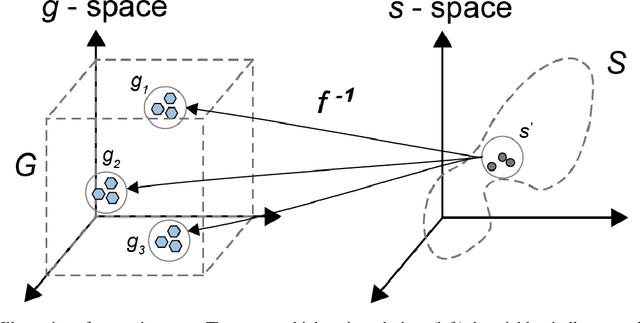

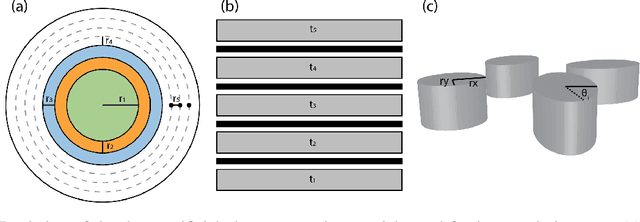
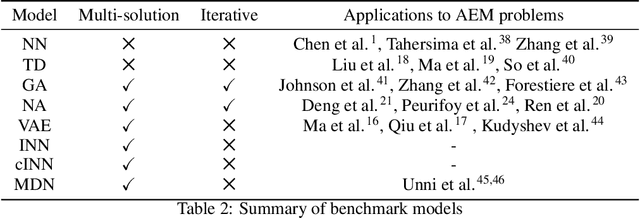
Abstract:Deep learning (DL) inverse techniques have increased the speed of artificial electromagnetic material (AEM) design and improved the quality of resulting devices. Many DL inverse techniques have succeeded on a number of AEM design tasks, but to compare, contrast, and evaluate assorted techniques it is critical to clarify the underlying ill-posedness of inverse problems. Here we review state-of-the-art approaches and present a comprehensive survey of deep learning inverse methods and invertible and conditional invertible neural networks to AEM design. We produce easily accessible and rapidly implementable AEM design benchmarks, which offers a methodology to efficiently determine the DL technique best suited to solving different design challenges. Our methodology is guided by constraints on repeated simulation and an easily integrated metric, which we propose expresses the relative ill-posedness of any AEM design problem. We show that as the problem becomes increasingly ill-posed, the neural adjoint with boundary loss (NA) generates better solutions faster, regardless of simulation constraints. On simpler AEM design tasks, direct neural networks (NN) fare better when simulations are limited, while geometries predicted by mixture density networks (MDN) and conditional variational auto-encoders (VAE) can improve with continued sampling and re-simulation.
Blaschke Product Neural Networks (BPNN): A Physics-Infused Neural Network for Phase Retrieval of Meromorphic Functions
Nov 26, 2021
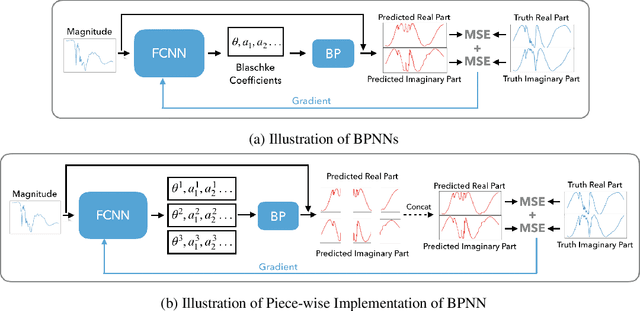
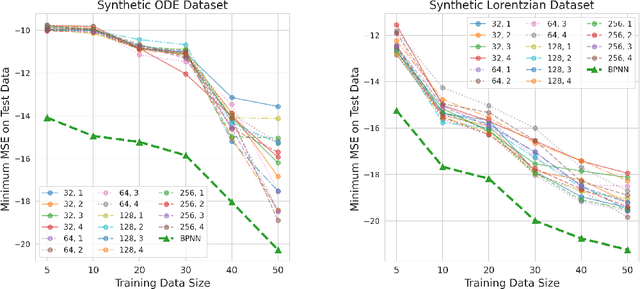
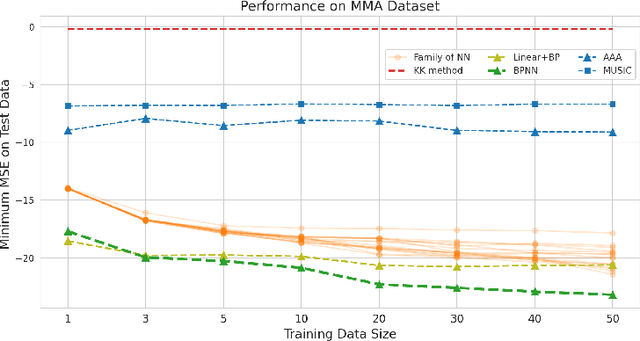
Abstract:Numerous physical systems are described by ordinary or partial differential equations whose solutions are given by holomorphic or meromorphic functions in the complex domain. In many cases, only the magnitude of these functions are observed on various points on the purely imaginary jw-axis since coherent measurement of their phases is often expensive. However, it is desirable to retrieve the lost phases from the magnitudes when possible. To this end, we propose a physics-infused deep neural network based on the Blaschke products for phase retrieval. Inspired by the Helson and Sarason Theorem, we recover coefficients of a rational function of Blaschke products using a Blaschke Product Neural Network (BPNN), based upon the magnitude observations as input. The resulting rational function is then used for phase retrieval. We compare the BPNN to conventional deep neural networks (NNs) on several phase retrieval problems, comprising both synthetic and contemporary real-world problems (e.g., metamaterials for which data collection requires substantial expertise and is time consuming). On each phase retrieval problem, we compare against a population of conventional NNs of varying size and hyperparameter settings. Even without any hyper-parameter search, we find that BPNNs consistently outperform the population of optimized NNs in scarce data scenarios, and do so despite being much smaller models. The results can in turn be applied to calculate the refractive index of metamaterials, which is an important problem in emerging areas of material science.
Benchmarking deep inverse models over time, and the neural-adjoint method
Oct 12, 2020


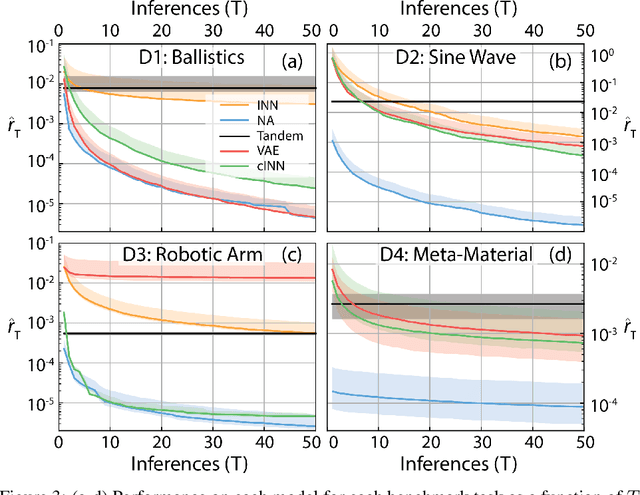
Abstract:We consider the task of solving generic inverse problems, where one wishes to determine the hidden parameters of a natural system that will give rise to a particular set of measurements. Recently many new approaches based upon deep learning have arisen generating impressive results. We conceptualize these models as different schemes for efficiently, but randomly, exploring the space of possible inverse solutions. As a result, the accuracy of each approach should be evaluated as a function of time rather than a single estimated solution, as is often done now. Using this metric, we compare several state-of-the-art inverse modeling approaches on four benchmark tasks: two existing tasks, one simple task for visualization and one new task from metamaterial design. Finally, inspired by our conception of the inverse problem, we explore a solution that uses a deep learning model to approximate the forward model, and then uses backpropagation to search for good inverse solutions. This approach, termed the neural-adjoint, achieves the best performance in many scenarios.
 Add to Chrome
Add to Chrome Add to Firefox
Add to Firefox Add to Edge
Add to Edge